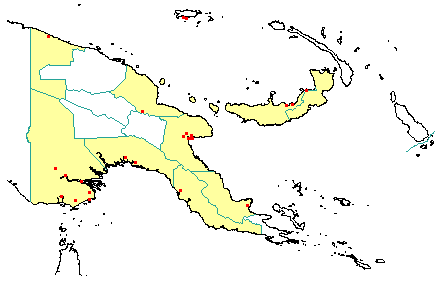
in PNGplants database
PNGTrees – Sonneratia caseolaris (L.) Engl. |
Barry Conn (NSW) & Kipiro Damas (LAE).
Copyright held by the authors, Royal Botanic Gardens and Domain Trust, and Papua New Guinea National Herbarium
Die Natürlichen Pflanzenfamilien Vol. 1: (1897)
Other Literature: M. Percival and J.S. Womersley, Floristics and Ecology of the Mangrove Vegetation of Papua New Guinea 88 (1975) Fig. 66.
Field Characters: Large trees rarely up to 45 m high or small trees 5-15 m high, often crooked straggly tree. Bole cylindrical 15-30 cm diam.; crooked or straight bole 2-5 m long; buttresses absent; spines absent; aerial roots absent; stilt roots absent with pneumatophores often twisted. Bark grey or brown, rough, irregularly scaly or flaky, sometimes pustular, or fissured longitudinally and horizontally; lenticels irregular; subrhytidome mottled, yellow, sometimes pink, or green; bark thickness <25 mm thick, 12.0-20.0 mm thick; blaze consisting of one layer; faintly to non-aromatic; outer blaze brown, pink, or pale yellow often straw-coloured, markings absent, fibrous; inner blaze pink, brown, or pale yellow often straw-coloured, markings absent, fibrous; exudate absent. Terminal buds not enclosed by leaves; complex hairs absent; stinging hairs absent; mature twig without hairs.
Leaves: Spaced along branches <internodes readily visible> tree often with dense foliage. Leaves opposite, simple; petiole present short, 5-8(-10) mm long, not winged, attached to base of leaf blade <not peltate>, not swollen; lamina broadest below middle, variable, broadest above middle, or broadest at or near middle, 4.0-13.0 cm long, 1.0-7.0 cm wide; lamina symmetric, margin entire, not dissected or lobed, apex obtuse, mucronate, or rounded, venation pinnate <secondary veins arising from the midrib along its length>, secondary veins open <spaced far apart to easily see tertiary veins>, not prominent, but visible, intramarginal veins absent; lower surface green or pale green, upper surface dark green or green, hairs absent; oil dots absent; domatia absent; stipules absent.
Flowers: Inflorescence terminal <at branch ends>. Flowers single <solitary> flowers bisexual, shortly stalked 5-8 mm long, with many planes of symmetry <actinomorphic>, 20.0-40.0 mm long, large (>10 mm diam.) 15-30 mm diam.; perianth present, with distinct sepals and petals, dark red or purple; inner perianth 6, free; stamens 100, filaments present red, white or pink, 25-45 mm long, free of each other, free of perianth; ovary superior <seated above petals and sepals; hypogenous>, carpels joined (when more than one) <syncarpous> styles solitary <including joined together>, 1 (up to 50 mm long).
Fruits: Fruits arising from single point. Fruit (10-) 20-40 mm long, 50.0-75.0 (calyx lobes flattened) mm diam., fruit green, not spiny, slightly fleshy, simple, indehiscent, berry. Seeds 100 (embedded in unpleasantly aromatic pulp), not winged, as wide as long.
Distribution: New Britain, Central, Gulf, Morobe, Northern, West Sepik, Western & Madang.
 | Botanical records in PNGplants database |
Notes: It is unclear if a narrow-leaf variant that has been collected from the Gulf (Katik and Kairo LAE62170) and the Western Provinces (Simaga 858) belong to this species. The fruiting calyx of the former collection has six or eight lobes. The frequency of this variation in the number of calyx lobes is not known.